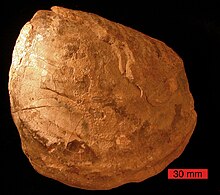
The Turonian is, in the ICS' geologic timescale, the second age in the Late Cretaceous Epoch, or a stage in the Upper Cretaceous Series. It spans the time between 93.9 ± 0.8 Ma and 89.8 ± 1 Ma. The Turonian is preceded by the Cenomanian Stage and underlies the Coniacian Stage.

Inoceramus is an extinct genus of fossil marine pteriomorphian bivalves that superficially resembled the related winged pearly oysters of the extant genus Pteria. They lived from the Early Jurassic to latest Cretaceous.

Platyceramus was a genus of Cretaceous bivalve molluscs belonging to the extinct inoceramid lineage. It is sometimes classified as a subgenus of Inoceramus.
The Matanuska Formation consists of more than 3 km (1.9 mi) of sedimentary strata exposed in the northern Chugach Mountains, Matanuska Valley, and southern Talkeetna Mountains of south-central Alaska. The Matanuska Formation contains strata from Early Cretaceous (Albian) to Late Cretaceous (Maestrichtian). Parts of the formation contain abundant marine mollusks, foraminifera, and radiolaria. Fossils of nonmarine plants are found in some beds. Fossils of two dinosaurs have been recovered from marine mudstones in the formation. The lower Matanuska Formation (MF) is several hundred meters thick and includes nonmarine and marine sediments. Campanian-Maastrichtian graded sandstone, conglomerate, and mudstone comprise the upper 2000 m of the Formation.

Calibanus is a subgenus of sea snails, cone snails, marine gastropod mollusks in the genus Conus, family Conidae, the cone snails and their allies.
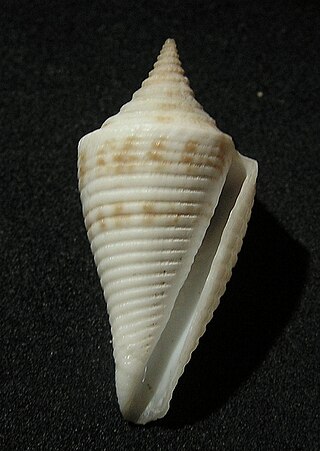
Conasprella is a genus of sea snails, marine gastropod mollusks in the family Conidae, the cone snails and their allies. This genus was formerly treated by some experts as a member of the family Conilithidae and as an "alternative representation" of this group of species.
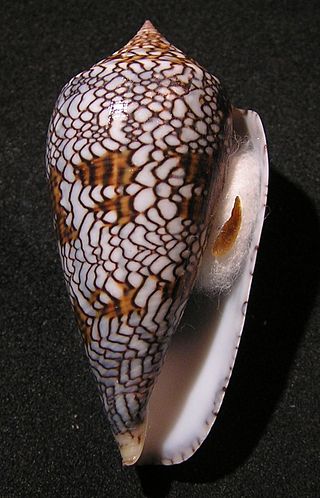
Cylinder is a subgenus of sea snails, marine gastropod mollusks in the genus Conus, in the family Conidae, the cone snails and their allies.

Eugeniconus is a subgenus of sea snails, marine gastropod mollusks in the genus Conus, family Conidae, the cone snails and their allies.

Floraconus is a subgenus of sea snails, marine gastropod mollusks in the genus Conus, family Conidae, the cone snails and their allies.
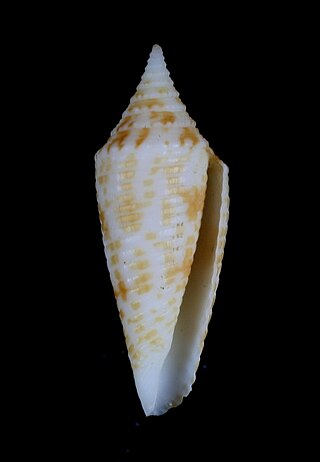
Fusiconus is a subgenus of sea snails, marine gastropod mollusks in the genus Conasprella, family Conidae, the cone snails and their allies.
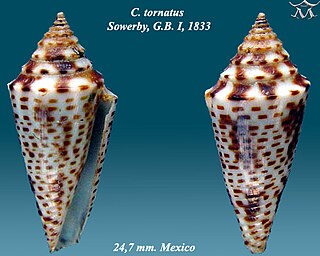
Globiconus is a subgenus of sea snails, marine gastropod mollusks in the genus Conasprella, family Conidae, the cone snails and their allies.

Gradiconus is a synonym of a subgenus of sea snails, marine gastropod mollusks in the genus Conus, family Conidae, the cone snails and their allies. T

Harmoniconus is a subgenus of sea snails, marine gastropod mollusks in the family Conidae, the cone snails and their allies.

Leporiconus is a subgenus of sea snails, marine gastropod mollusks in the genus Conus, family Conidae, the cone snails and their allies.
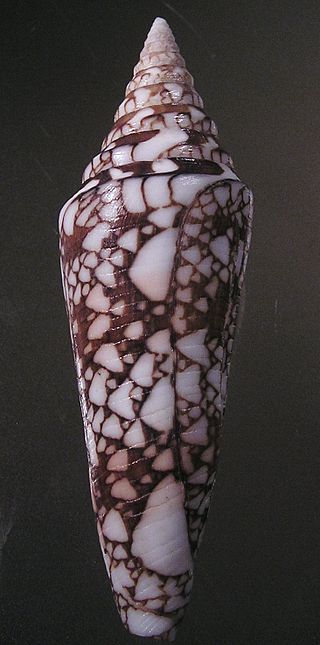
Leptoconus is a subgenus of sea snails, marine gastropod mollusks in the genus Conus, family Conidae, the cone snails and their allies.

Lividoconus is a subgenus of sea snails, marine gastropod mollusks in the genus Conus, family Conidae, the cone snails and their allies.

Perplexiconus has become a synonym of Conasprella (Ximeniconus) Emerson & Old, 1962, a subgenus of sea snails, marine gastropod mollusks in the family Conidae, the cone snails and their allies.

Inoceramus cuvieri is an extinct species of the extinct genus Inoceramus of Bivalve mollusks that serves as an index fossil of chalky rocks of Turonian age of the Cretaceous Period in Europe and North America.

Cremnoceramus is an extinct genus of fossil marine pteriomorphian bivalves that superficially resembled the related winged pearly oysters of the extant genus Pteria. They lived from the Turonian to the Maastrichtian of the Late Cretaceous.
Cladoceramus is an extinct genus of fossil marine pteriomorphian bivalves that superficially resembled the related winged pearly oysters of the extant genus Pteria. They lived in the Santonian stage of the Late Cretaceous.
